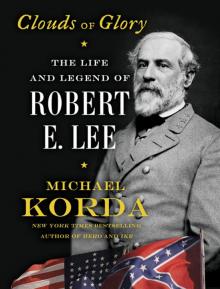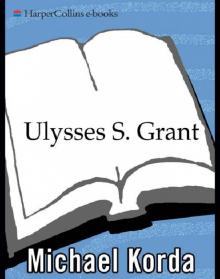- Home
- Michael Korda
Clouds of Glory Page 52
Clouds of Glory Read online
Page 52
). The two rivers were twenty miles apart at the wide end of the > and joined together about ten miles west of Fredericksburg, forming an area shaped like a slice of pie.
14. The junction of the Rappahannock and Rapidan rivers.
{Robert E. Lee, Volumes 1, 2, and 3, by Douglas Southall Freeman, copyright © 1934, 1935, by Charles Scribner’s Sons, copyright renewed 1962, 1963, by Inez Godden Freeman. All rights reserved.}
Pope had incautiously allowed his army of 60,000 to 70,000 men to concentrate “within the ‘V’ between the two rivers,” a situation made more perilous by the fact that there was only one major bridge over the Rappahannock in the immediate area. If Stuart’s cavalry could ride around Pope’s army and destroy the bridge at Rappahannock Station, a vigorous attack on Pope’s left might cut off him off from being reinforced by McClellan through Fredericksburg and trap him between the two rivers.* Lee could effectively annihilate Pope’s army before McClellan’s could be brought from the peninsula to join with it—just the decisive victory Lee had failed to achieve over McClellan at Malvern Hill. Lee had 55,000 men, enough to do the job if he struck before Pope and McClellan joined. Here was a window of opportunity if ever there was one, but it would be open only briefly. Jackson was right—an immediate attack was Lee’s best opportunity for a victory, but in order to annihilate Pope, Lee would have to wait until Stuart could destroy the vital Rappahannock Station bridge.
And there was the rub: not Longstreet’s caution, but the fact that Stuart had only one brigade of cavalry. The rest of his division had been left behind in Richmond; its horses were tired and in desperate need of rest. Lee had foreseen this. “Endeavour to spare your horses as much as possible,” he had written to Stuart on July 18, almost a month ago—but the rigors of the war and the intense heat had, as always, a greater effect on the horses than on the men, and horses, unlike men, could be pushed only so far before they broke down, and were not spurred on by patriotic sentiment or eagerness for victory. All, therefore, depended on the brigade’s commander, Lee’s nephew Fitzhugh Lee, a former instructor of cavalry tactics at West Point.† Fitzhugh Lee was cast in the same mold as J. E. B. Stuart—a daring, dashing, high-spirited, fiercely bearded Cavalier—but there is some doubt whether he had been informed that his uncle’s whole plan hinged on the speed of his advance.
Stuart had ordered Fitzhugh Lee to advance with his brigade from Beaver Dam, where he was bivouacked, to Raccoon Ford on the Rapidan, a march of sixty-two miles to join Stuart. This would have been a severe challenge for his horses to make in two days. The Rapidan, more so than the Rappahannock, was a river with shallow banks and many well-marked fords at this time of year; most of the fords were shingle and offered an easy crossing to horses and artillery, though infantrymen were likely to have to wade through knee- or waist-high water. As it was, Fitzhugh Lee added to the length of his journey by making a detour to Louisa Court House to feed his men and horses and replenish his ammunition—a sensible decision, but one which would seem to indicate that Stuart had failed to impress on him the need to reach Raccoon Ford by the evening of August 17.
This would become one of the more contentious questions about the war. Longstreet would later claim that the war was lost by Fitzhugh Lee’s failure to have his brigade in position in time, but by then Longstreet himself had become perhaps the most contentious subject of all. It seems more likely that Fitzhugh Lee had no idea that Lee proposed to attack on August 18, let alone that this attack depended on him. Longstreet censured him in extreme terms, calling the detour “a pleasure ride” and going so far as to write that Fitzhugh Lee “lost the fruits of our summer’s work, and lost the Southern cause.” In any case Stuart does not seem to have held it against him in the future; Fitzhugh Lee retained his command, and the two men remained friends, even though Fitzhugh Lee’s failure to arrive on time was to put Stuart himself in danger.
Stuart had taken command of Jackson’s cavalry, amounting to at least another brigade; and Jackson raised no objection, since he had no faith in his own cavalry commander, Brigadier General Beverly Robertson, and had been trying to replace him since the beginning of August, although Lee, deluged with other personnel problems and several courts-martial, had declined to do so. Placing all the cavalry, including Robertson’s brigade, under Stuart, was a sensible move on the face of it, but also typical of the kind of compromise Lee often made to solve such problems—Jackson was partially satisfied, and Lee did not have to deal with the unpleasantness of removing Robertson from his command.
On August 17 Stuart rode east from Orange to Verdiersville, a sleepy hamlet a few miles south of Raccoon Ford, where he expected to find Fitzhugh Lee’s brigade waiting for him, but there was no trace of it. A cavalry brigade is not easy to miss in comparatively open country, but none of the locals had seen it either, so Stuart sent one of his officers (a major confusingly named Norman Fitzhugh) to search for it, and settled down for the night on the porch of a house. At first light on August 18 he was woken by the “clatter of hooves” and the jingling of bridle chains, clearly signaling the arrival of cavalry, but as he rose from his makeshift bed he heard a voice cry out that it was “Yankee cavalry.” Shots rang out, and Stuart quickly mounted his horse, jumped a fence, and—hotly pursued by Federal cavalrymen—galloped into the woods, followed by his staff. The Federals captured Stuart’s famous plumed hat and his silk-lined cloak, a loss that he deeply resented; more important, they also captured Major Norman Fitzhugh, who had returned from his vain hunt for Fitzhugh Lee just in time to witness his commander’s bold escape. Norman Fitzhugh had on his person a copy of Lee’s orders for the attack, so by August 18 Lee’s plan was in Pope’s hands.*
Lee had already postponed the attack to August 20, with great regret, since it was clear that Fitzhugh Lee’s horses would need a day of rest once they actually arrived, but by that time it was too late. Pope was perhaps not the brightest of the Union generals, but once he had read Lee’s orders he was quick enough to see that he had fallen into a trap. By the early afternoon on August 18 he was already beginning to withdraw his army to the north of the Rappahannock. Lee and Longstreet rode together to the summit of Clark’s Mountain, a large wooded hill just over 1,000 feet high with a spectacular view from the summit toward the northeast, in the late afternoon of August 19, only to see the last of Pope’s tents being struck and his rear guard marching toward the Rappahannock, bayonets glinting as they “melted into the bright haze of the afternoon sun,” and out of Lee’s trap. “General,” Lee said, according to Longstreet, “we little thought that the enemy would turn his back upon us this early in the campaign.”†
One mark of great generalship is the ability to turn on a dime when your plans fail. Lee now faced the problem of what Pope would do next. If Pope turned east he might get between Lee and Richmond, and at the same time join with McClellan’s army. If he turned west, he might succeed in recrossing the Rappahannock farther upstream and turning Lee’s left.
Clearly, Lee now had to pursue Pope and bring him to bay before McClellan joined him to form an army of some 120,000 men. Early on the morning of August 20 Lee’s entire army crossed the Rapidan unopposed over its many fords, “a sight worth seeing,” as one soldier observed: 54,500 men in all, including the cavalry—Jackson, with Stuart’s cavalry, forming the left; and Longstreet, with Fitzhugh Lee’s brigade of cavalry, forming the right. Lee was still determined to fight Pope before he and McClellan could unite, and seems at first to believe that Pope would move east toward Fredericksburg. Instead Pope began to extend his line toward the west, covering the Rappahannock and moving toward Warrenton, as if he were trying to draw Lee farther and farther from Richmond. Through August 21 and 22 Lee rapidly moved his army upstream from ford to ford along the Rappahannock, from Kelly’s Ford to Beverley Ford, looking for a place to cross in force, while Pope ably checked his every move. Late on August 22, Jackson at last managed to get a substantial force across the river at Sulphur Springs Ford, about ten miles north of Rappahannock St
ation, well beyond the right of Pope’s army. Lee sent Stuart with 1,500 horsemen, including the Ninth Virginia, led by Lee’s son Rooney, on a daring raid around the Union right all the way to Warrenton, hoping to destroy one of the small railroad bridges at Cattlett’s Station, almost twelve miles behind the Union columns along the Rappahannock, and cut off Pope’s supply line. Stuart did not arrive at Cattlett’s Station until that night, in the middle of a pouring rainstorm that made it impossible to set fire to the timbers of the bridge. His troopers did little damage to it with axes, but it turned out that Stuart had stumbled across General Pope’s headquarters. Stuart cut telegraph lines: captured 300 prisoners; perhaps more important, took Pope’s dispatch book; and also took—surely a balm to Stuart’s bruised pride—Pope’s best uniform coat, as well as his hat. Fitzhugh Lee came very close to capturing his own cousin Colonel Louis Marshall, the son of Lee’s beloved sister Anne in Baltimore. Marshall, who was serving on Pope’s staff, saved himself at the last moment “by rushing out the rear of his tent, leaving his toddy untouched.” Writing about Louis Marshall to Mary, Lee commented, “I am sorry he is in such bad company, but I suppose he could not help it.” Stuart was so pleased by his exploit that he sent Pope a letter under a flag of truce offering to return Pope’s dress coat in return for his own plumed hat, but Pope does not appear to have shared Stuart’s high-spirited sense of humor.
The heavy rain raised the water level of the river instantly—one big storm was all it took to make the fords impassible—and when Stuart arrived back at Sulphur Springs Ford he found that Jackson’s engineers were rebuilding a bridge burned by the Federals to “extricate” the forces he had sent across the previous day.
By August 23 Lee had most of Pope’s papers in his hands; these gave the exact number of Pope’s men and his artillery, and made it clear that Pope’s plan was to preserve his line on the Rappahannock until McClellan and his army could advance to Fredericksburg and join him. This was something less than a daring strategy on Pope’s part—in effect, he was planning to mark time in place until McClellan, not normally a bold or fast mover himself, arrived. Lee again saw that it was a race for time between himself and McClellan. There was an opportunity, a fleeting one, to defeat Pope, then turn on McClellan, and thereby gain the “annihilating” victory that was, in Lee’s view, the only way to win the war.
Because the South eventually lost the war, and because Lee’s defeat on the third day of Gettysburg now seems to many people in both the South and the North to have ended the last chance of a Confederate victory, Lee’s generalship has been a controversial subject for a century and a half. In the South, Lee’s defeats are generally attributed to overwhelming numbers against him—the Union could and did mass more men than the Confederacy, and had a significant advantage in terms of capital and industry, so that Confederates were as a rule not only outnumbered on the battlefield, but also outgunned and outsupplied. There is some truth to this—Lee himself frequently commented on it with a mixture of resignation and mild criticism in his letters to Jefferson Davis: “The army is not properly equipped for the invasion of an enemy’s territory. . . . Feeble in transportation . . . animals being much reduced . . . men are poorly provided with clothes, and in thousands of instances destitute of shoes.” Nobody could have been more aware than Lee himself of his army’s weaknesses, nor of the Confederate government’s inability to remedy them. The boldness of his maneuvering and the rapidity with which he fought one great battle after another were in large part a reflection of this—the enemy might gain strength by resting in position and waiting on events (essentially what McClellan wanted to do), but Lee would not. He would lose men he could not replace, from death, wounds, disease, semi-starvation, “straggling,” and desertion. The whole Confederacy was a race against time: for Jefferson Davis, to secure the will-o’-the-wisp of foreign recognition and support; for Lee, to inflict on the Union a defeat so complete and humiliating that northerners would lose heart and give up the war.
Criticism of Lee’s generalship was muted during his own lifetime, but by no means entirely absent. Longstreet, despite his affection and admiration for his old chief, did not hesitate to voice his criticism of Lee’s strategic decisions and battlefield tactics after the war; and Lee deflected it with a certain degree of wry good humor. Once Longstreet committed himself to writing his memoirs, his criticism of Lee became sharper, and at times even personal, and brought down on his own head an avalanche of refutation and indignation by angry southerners. That avalanche is still falling, and is reflected in popular culture by Michael Shaara’s Pulitzer Prize–winning novel The Killer Angels (1974) and by the film Gettysburg that was based on it, for example, and by Alan T. Nolan’s more scholarly Lee Considered: General Robert E. Lee and Civil War History (1991), all tending to reflect Longstreet’s point of view. These views of Lee as a general (and indeed as a man) run counter to those of the southern establishment and tend to be based not just on Longstreet’s arguments with Lee about tactics at Sharpsburg and Gettysburg, but on his broader view that Lee should have fought from the beginning a defensive war, rather than seeking out and attacking the enemy.
How so large an area as the Confederacy (at just under 800,000 square miles, it represented almost a quarter of the landmass of the United States), with a population of only 9 million people, of whom at least 3.5 million were slaves, was to defend itself, Longstreet did not venture to suggest, either to Lee or to the reader of his memoirs, and for good reason: a static defense of the Confederacy was manifestly impossible once war had begun. No army it could raise would be big enough to defend it, and the result would have been history’s most emphatic proof of Frederick the Great’s famous remark that “he who attempts to defend everything, defends nothing.” Lee was from the start committed to an offensive defense, in which he maneuvered constantly to survive and fought each battle in the hope that it would be the last.
The case against Lee’s generalship was summed up best by Major-General J. F. C. Fuller, CB, CBE, DSO, the influential British strategic thinker and military historian, in his book Grant and Lee: A Study in Personality and Generalship (1933). “Lee was no grand-strategist,” Fuller wrote, “for he refused to be influenced by policy or to influence it. His theory of war was based upon the spirit of his army which he considered to be invincible. He understood the valor of his adversaries, though he read like a book the character of many of their generals, and on the whole had the highest contempt for their abilities. His cause was a moral one, and his attacks were also moral ones.” (When Fuller writes of Lee’s cause being “a moral one,” he is, of course, thinking not of slavery or even secession, but of Lee’s firm conviction that he was “unwilling to do what is wrong at the bidding of the South or the North,” and his refusal to acquiesce in the right of the Federal government to raise an army against its own citizens, or, as Lee put it to General Winfield Scott, “to raise my hand against my children.”)
Disentangling Lee from his myth is no easy task—even so astute and balanced a military historian as Colonel G. F. R. Henderson, CB, the distinguished nineteenth-century British biographer of Stonewall Jackson, could write, “General Lee [was] one of the greatest, if not the greatest soldier who ever spoke the English tongue,” thus carefully reserving a place apart for Napoleon, while demoting Wellington to second place among English-speakers. Fuller, despite his admiration for Lee’s character, will have none of this. His criticisms of Lee as a general are noteworthy, perhaps because they have become fixed in the minds of northern historians, and echo throughout much of the history of the Civil War. Fuller finds that “the central weakness of [Lee’s] character” was that he was unwilling to enforce discipline, and played the role of a saint rather than a commanding general; that his “dread of wounding the feelings of others” prevented him from criticizing or sacking his own generals; that he was unwilling to force his own will on others; that he was poorly served by his staff and unwilling to change them; and that his orders were often unclear an
d based on insufficient information. Fuller further criticizes Lee for allowing his corps and divisional commanders too much authority, and for not exercising close personal control over his battles.
There is an element of truth in all this. Gentlemanly behavior was perhaps more important to Lee than it should have been; he certainly disliked personal confrontations and went out of his way to avoid them; and his staff, however devoted, was so small that he ended up doing much of the work himself. The fact that he was willing to leave the outcome of a battle in the hands of God was typical of Lee’s intense religious faith—Stonewall Jackson often expressed the same belief; in fact he repeated it like a mantra, to the annoyance of many of his generals—but does not mean that Lee abandoned control over his armies once they were on the battlefield, like a rider dropping the reins of his horse.
On the other hand, each of these charges can be refuted. His “lack of thunder,” the contrast between Jackson’s Old Testament fire-and-brimstone ruthlessness and Lee’s polite calm, did not prevent Lee from recommending a much stricter rounding up of stragglers, or from having deserters shot; despite his dislike of confrontations, he managed to move on generals who had failed or disappointed him; his written orders are as detailed and clear as anybody could wish; and his staff diligently carried out his instructions. True, paperwork exhausted and irritated him; even his own patient, faithful aide Walter Taylor noted that “nothing seemed to tax his amiability so much as the necessity for writing a lengthy official communication,” but he is not the only general to complain about this (aides said the same thing about Eisenhower). Also true, Lee displayed what might seem to some (and did seem to Fuller) an excessive deference to Jefferson Davis, but Lee was not a politician, nor had he any ambition to become a military dictator and replace Davis; if the Confederacy could have been saved only by Lee’s following the examples of Caesar, Cromwell, and Napoleon, Lee would have preferred defeat—he was too much an American for that.

 Passing
Passing Another Life
Another Life Clouds of Glory
Clouds of Glory Hero: The Life and Legend of Lawrence of Arabia
Hero: The Life and Legend of Lawrence of Arabia Cat People
Cat People Hero
Hero With Wings Like Eagles: A History of the Battle of Britain
With Wings Like Eagles: A History of the Battle of Britain Ulysses S. Grant
Ulysses S. Grant